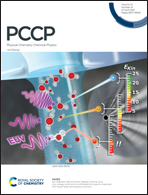Excited state dynamics of BODIPY-based acceptor–donor–acceptor systems: a combined experimental and computational study†
Abstract
Donor-bridge-acceptor systems based on boron dipyrromethene (BODIPY) are attractive candidates for bio-imagining and sensing applications because of their sensitivity to temperature, micro-viscosity and solvent polarity. The optimization of the properties of such molecular sensors requires a detailed knowledge of the relation between the structure and the photophysical behavior in different environments. In this work we have investigated the excited-state dynamics of three acceptor–donor–acceptor molecules based on benzodithiophene and BODIPY in solvents of different polarities using a combination of ultrafast spectroscopy and DFT-based electronic structure calculations. Transient absorption spectra show that upon photoexcitation an initial excited species with an induced absorption band in the near-infrared regime is formed independent of the solvent polarity. The subsequent photophysical processes strongly depend on the solvent polarity. In non-polar toluene this initial excited state undergoes a structural relaxation leading to a delocalized state with partial charge transfer character, while in the more polar tetrahydrofuran a fully charge separated state is formed. The results clearly show how factors such as donor–acceptor distance and restricted rotational motion by steric hindrance can be used to tune the excited state photophysics to optimize such systems for specific applications.



 Please wait while we load your content...
Please wait while we load your content...